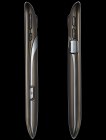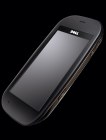Windows Marketplace has officially stepped into its next stage of development. There's a new desktop client now and you can buy apps directly from your PC and later install them on your Windows Mobile 6.5 smartphone. Marketplace support for devices based on WinMo 6.1 and 6.0 is expected later this month. Starting today you can buy application from the Windows Mobile Marketplace through your desktop computer. When you buy yourself some apps on the desktop computer, they will be downloaded automatically to your smartphone as soon as you open the mobile Marketplace client. The second Marketplace that has been updated is the anti-piracy measures and while the average users won't feel any changes, the developers will surely be happy there's more protection for their paid apps. If you are a developer you may need to read the anti-piracy whitepaper to understand the new security system. Microsoft also announced that they will launch the Windows Marketplace for WinMo 6.0 and 6.1 later this month, so those of you with older OS versions won't have to wait long.
The guys over at Mozilla are organizing a contest for Maemo mobile browser add-ons and are willing to award the top 10 developers with a new Nokia N900 each. If you're a developer, you can participate in the contest by submitting your add-on for the mobile Firefox browser for Maemo at the contest homepage. The Maemo 5 based Nokia N900 started shipping a few days ago but we guess it will be a few days before all stores get theirs. So this challenge is your chance not only to get it for free but also to be among the first N900 owners. To participate you have to develop an add-on for the mobile Firefox web browser and submit it before December 7, 2009.The judges will choose which TEN addons offer best user experience and innovation. If you already have developed an add-on for the mobile Firefox, you only have to confirm that you want to take part in the challenge. Well, that is. For further details on the rules follow that link. The organizers are ready to supply the participants with all the needed SDK tools as well as with useful tips and personal advices. The deadline is just around the corner so hurry up. The clock is ticking.
It seems that the launch of the Bada OS hasn't spelled doom for the Samsung Symbian / WinMo portfolio after all. The company has contacted us and denied the claims made by HMC Investment Securities about Samsung leaving only Android and Bada as their operation systems of choice in the foreseeable future. Here is what the official statement says: Samsung has not made any change in its strategy of supporting multiple open operating systems. We believe this strategy continues to provide consumers with a variety of choices of rich mobile content and applications. To provide more choices to meet consumers' many different taste and preference, we will continue our 'multi-OS' strategy. As an an initial member of Symbian Foundation, Samsung continues to cooperate with Symbian Foundation. Windows Mobile is also an established operating system with solid market position and its own set of strengths. Samsung will continue working closely with Microsoft to provide a range of continually evolving Windows Mobile based smartphones in the coming years. So obviously Symbian and WinoMo fans have nothing to worry about. One of the major players promises to remain in the game and so we should expect more cool devices to come with the two platforms.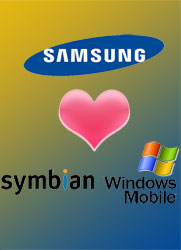
Just by reading our articles you may or may not have noticed that we, the GSMArena team members, are as passionate about other high-tech stuff as we are about cellphones. Well, we are... So starting from today, we will materialize our interest in various high-tech gadgets into writing and we went for blogging as the most appropriate form of web publishing to do that. Our personal passions and interests stretch way beyond mobile phones. Whether it is digital cameras and DSLRs, computers, laptops, computer hardware, robots or just plain sci-fi movies, you name it, we've probably got it covered. So quite naturally, it occurred to us that perhaps you'd be interested in getting our scoop of the most interesting tech toys of the day (and if you're not, you can always skip it). We hardly miss an announcement or a demo of an exciting new gadget and we thought it's about time we start noting those in writing. Which gets us to our main point today and that is the announcement of our very own GSMArena tech blog: Geeks at large. Well, before you jump up and say there are already a million of those out there, we'd like to make a few things clear. First off, it is going to be only a blog - a side project, something our team members do in their spare time driven by their love for gadgets. Our blog is meant to be personal and as such will express our personal opinions about the discussed topics. Secondly, by having our personal say through the blog, we'd be able to release cellphone news and even coverage that we normally don't provide through GSMArena.com for various reasons (political correctness being one of them). And finally, besides providing news coverage, the GSMArena blog will give us an opportunity to review other products besides cellphones. We'll even be able to post our research on interesting high-tech topics that don't necessarily have something to do with mobile phones. The GSMArena blog can also be a place to share some funny stuff we come upon and if you've come to appreciate what our team does in the field of mobile phones, you'd certainly find it interesting to see us covering other things as well. We've already prepared a bunch of posts during the blog web development. But before you head on and check them out, we'd like to pass on this little disclaimer. The GSMArena team blog is a place for team members to express their personal opinions. Those don't necessarily coincide with the official GSMArena.com say on the matter. Well, that's about it. Happy reading!blog.GSMArena.com
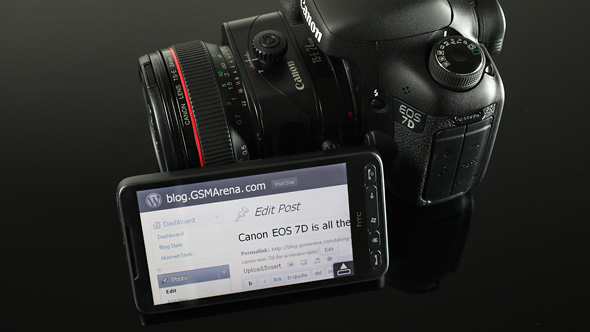
HTC HD2 is now available in Vodafone UK. You can get one for free on 24 month contract and 35 pounds tariff or on 18 month commitment at 40 pounds tariff. The offers seem similar to iPhone plans through Orange and O2 so we guess Christmas shopping will pose quite some tough choices for the gadget lover. The monstrous HTC HD2 is now available in the Vodafone UK network and you can have yours for free on either 18 or 24 month contract. A free HD2 applies to the 35 pound monthly tariff and the 24 month contract, while if you opt for the 18 month contract, you'll have to opt for a 40 pound monthly plan. Truth be told, those offers are similar to the Orange iPhones's, so in the Christmas hype all will be up to the device, not the operator or tariff.
A whole range of Dell Mini 3 smartphones now official, sort of
After giving up their PocketPC business several years ago Dell are ready for a come back but this time they will try to conquer a much wider field. Now it's as official as it gets: Dell have just confirmed their plans to produce a range of smartphones under the brand name Dell Mini 3. Judging on Dell's netbooks naming convention, which takes after the screen size, it's a good guess that the new Dell smartphones will all have 3 inch screens.
And when it comes to Dell future smartphones, we have to resort to guessing, as the company did not announce any hardware specs whatsoever. Those will be announced "...when devices are available in stores." Dell marketing obviously can't get over their computer marketing strategies (much like Acer and their newbie attempts, as well).
Anyway, rumors on Dell smartphones have been circulating for the past 2 years or so and a few months back the Dell Mini 3i was even sighted during an event organized by China Mobile. Back then Dell called it only "a proof of concept" but today it just can't get any more real than that.
The first company across the globe to get the Dell Mini 3 is world's largest mobile operator, namely China Mobile. Their version of Dell Mini 3 will run the OPhone OS (basically that's the well-known Android OS with some minor customizations) and is expected to become available sometime this month.
The Chinese version however won't have 3G and Wi-Fi. The first 3G-enabled Dell Mini 3 will be offered in the Claro network in Brazil. If you don't live on the American continent, chances are you might have never heard of Claro, but they are actually part of America Móvil, the largest mobile phone network in America. The Dell Mini 3 will be available in Claro by the end of the year.
So as it turns out, Dell Mini 3 is actually a name for full range of devices sold in different configurations and OS options. Unfortunately, Dell refused to unveil more information on the exact specifications. All we know is that they will all feature touchscreens and will be designed around the Android OS. The rest of the technical details will be announced by the time of the official market launch of the Dell Mini 3 smartphones. Pricing remains unknown as well.
The ITG xpPhone that we already told you about is going to come in more than one flavor. The future users will be able to pick the OS, CPU, storage and RAM memory as well as the display to create a device that suits their needs the best. The handset will be available with Windows XP, MS DOS or Windows 7 (there goes the nice name) OS and AMD Super Mobile CPU. The options for the CPU speed are over and under 1GHz but the manufacturer doesn’t quote exact numbers. The storage memory ranges from 8GB SSD to 120 GB HDD and the RAM will be 512MB, 1GB or 2GB. There will also be three different versions of the touchscreen LCD – 4.3”, 4.7” and 7” with resolution of either 800 x 480 or 1024 x 600 pixels. Finally, the users will be able to pick between VGA, 1.3 MP, 3MP and 5MP for the xpPhone’s camera. WiMax connectivity can also be added to the 2G and 3G GSM and CDMA-enabled phone. There isn’t information about the exact pricing of the device just yet but the form for pre-order is already available at the company’s website. Though we wouldn't advise you to get your credit card right away - not at least we see some live images of the thing up and running.
A new intriguing mobile form factor concept comes from the Brazilian designer Fabio Dabori. The so-called HOOK promises to innovate the keypad locking mechanism and push the future mobile designs to a new direction of smaller, more compact handsets.
The HOOK concept is actually quite simple - a standard bar phone receives a hook (metal or plastic) embedded around its keys. The hook can be either flippable or sliding as shown on the design mock-ups below
This hook can help and innovate the current technologies in two ways. The first one concerns the keypad lock/unlock mechanism. Instead of pushing at least two buttons for the lock or unlock sequence you will be able to do that with only one flip or slide of the hook.

Next and most important is that manufacturers can put the microphone at the bottom of the hook. This can lead the mobile designs into more compact sizes and even some artistic shapes, because the microphone will still be near the mouth thanks to the flipping/sliding hook

Of course the HOOK brings one big concern - something protruding out of the handset (especially that thin) is usually easily breakable. So if some day this concept gets a green light, the hook should either be quite solid or it might turn out quite a bummer.
You are welcome to share your thoughts about the HOOK design in the comments
The second wave of Nokia touch phones and the first wave of the Xseries is coming to town - the Nokia X6 is already available for preorder with an expected date of release 12th of November, complete with Comes With Music.
The Comes With Music service allows you to download songs to your heart's content - 12 months of downloads (free of charge, except for possible data charges) and you get to keep the songs after that period runs out. Good thing that the Nokia X6 comes with 32GB of internal memory, isn't it?
The price of the Nokia X6 (network-unlocked) is a bit steep though - Expansys has it at 530 pounds with taxes (590 euro or 876 US dollars). Unluckily there won't be a version without the Comes With Music service at the launch of the phone. Just bear in mind that the headphones you get in the box are far from ordinary - check out the WH-500.
Nokia Germany also has the X6 listed for pre-order for 580 euro but they don't offer info on availability
You can save yourself a few bucks by simply upgrading your Ovi Maps 2.0 software to the latest version 3.0 by following that link. Your free license for pedestrian voice guided navigation will be delivered by SMS.
However, here comes a slight disappointment. As it turns out, the limited offer is available only in Germany or for Nokia users that actually have an active German SIM card. We found this banner on the German website of the company and it doesn't seem to be listed elsewhere. That's a bummer, we know

Here is how you can get the free license (text in German)
The license type and the validity period is not known. But whatever it is, it's free after all .
While some companies make their way to the top using others' achievements, there are still ones that are willing to pay for patent licenses without mumbling too much. Like Samsung who have just signed an agreement with Qualcomm, according to which the Korean company will have to pay a fortune for some patents owned by Qualcomm.
That happens just a few weeks after we've found out that Nokia decided to sue Apple for not paying a dime for a dozen of Nokia-owned patents (including ones related to GSM, UMTS and WLAN). Word on the street is that Nokia might get up to billion and a half US dollars if Apple is proven guilty.
Samsung agreed to pay the CDMA patent holder (read: Qualcomm) nearly the same amount, namely 1.3 billion US dollars, in order to get Qualcomm's permission to use its CDMA, WCDMA and OFDMA patents.
That sounds like a fortune and it actually is: that makes approximately 80% of the 2009 net income of Qualcomm (good 1.59 billion US dollars). But as it turns out, this deal is a steal: the fees depend on company and market area, however, Samsung managed to get the lowest price.
Anyway, this is just the amount which is about to be paid in advance and there will be some additional royalties for the next 15 years, but they were not disclosed
Oh, iPhone. Every shop wants thee. RadioShack, or “The Shack” as hipsters call it, announced that it will be offering the iPhone 3G and 3GS by the end of this month to a limited number of stores initially.
Their press release (if you could call it that), offers little more information – the iPhone will be available in RadioShack stores in the New York metropolitan area and in the Dallas-Fort Worth. The iPhone will be available nationwide at RadioShack store some time in 2010.
Only the iPhone 3G and iPhone 3GS versions will be available, the original 2G version graciously stepped down a while ago, leaving room for iPhone Mini rumors. These iPhone Mini, AMOLED screen, iTablet, etc. rumors crop up on a regular basis. We haven’t checked, but our guess is they coincide with the full moon.
Here’s what the current rumor from the town’s tavern is – a UMTS/CDMA hybrid iPhone, with a smaller 2.8” screen. The smaller-screen iPhone rumor isn’t new, it’s just resurging, probably because it’s something people would be interested in if it was true.
The UMTS/CDMA hybrid is a different matter. The AT&T exclusivity for the iPhone is coming to an end, but the USA is a country divided as far as mobile carriers go. Some use UMTS, others - CDMA. Verizon, the biggest US carrier, uses CDMA and they’ve said they would be interested in getting the iPhone (who wouldn’t?) and rumor has it they will get it in the third quarter of 2010 (the UMTS/CDMA hybrid apparently).
Take this with a grain of salt, as current CDMA carriers seem to be jumping ship to LTE – the fourth generation of GSM. We wonder how long it will take for an LTE iPhone rumor to surface.
Yesterday, Motorola announced their Android 2.0 CDMA phone - the Motorola DROID. GSM users have nothing to worry about as the GSM version of the phone already passed through FCC testing and Vietnamese forum Tinhte.com has posted a live video and photos of it. We've already seen the DROID in action - yesterday when Google announced their Google Maps Navigation SatNav solution, they used the CDMA-based Motorola DROID to do the demonstration. To put it simply, the Motorola DROID is to the original Android phone, the G1, what a Ferrari is to a Ford Model T. The new and improved Android v2.0 Eclair is bringing plenty of usability updates and the ARM Cortex A8 CPU clocked at 550MHz should give a noticeable bump in speed. Despite being similar in clock speed to the 528MHz CPU in the G1, the Cortex A8 architecture delivers more performance per clock. So far, the hardware specs for the GSM version of the DROID are unconfirmed but they should be pretty close to the CDMA version. That means a 3.7" TFT display with 480 x 854 pixels resolution, capacitive touchscreen technology (with multitouch support as you can see in the video), a 5MP camera with autofocus and dual-LED flash (and the much improved camera interface of the new OS), D1@24fps video recording. The wireless connectivity is excellent - speedy HSDPA (10.2Mbps) and HSUPA (5.76Mbps), Bluetooth 2.0 (with file transfer), Wi-Fi and A-GPS (with Google Maps Navigation). The Motorola DROID offers roomy 16GB internal memory (either on a card or embedded).
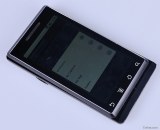
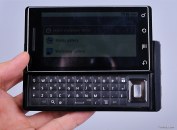
Photos of the GSM version of the Motorola DROID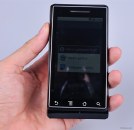

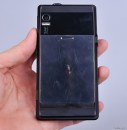
Android phones have come a long way since the beginning
HTC are taking care of their existing Android devices - first it was Sense UI for the HTC Magic, now we hear that the HTC Hero is getting an Android 2.0 update. There's no specific timeframe for this update but at least it will be global, unlike the (so far) Taiwan-only Sense UI update for the Magic. HTC have already confirmed to be working on phones using Eclairand Hero owners will be pleased to hear that they're getting it too. HTC are currently busy with porting the Sense UI to the new version of Android, which saw plenty of changes under the hood, so they need to rewrite things and get them tested. The update will be available for all versions of the Hero - since the Hero is not a "Google" phone there are no licensing restrictions in its way to getting the update - exactly the thing that stands between the Magic and Sense UI. Poor HTC Magic owners are yet again put in doubt - the hardware should be able to handle Android v2.0 as it's mostly the same as the one in the Hero, but HTC didn't mention plans for such an update. The devs over at xda-developers.com will probably create a custom ROM anyway, so if you're not afraid of modding your keep an eye on them.
We've shown you the ITG xpPhone before but now there are screenshots of the user interface so we thought we should tell you all about it. The ITG xpPhone is kinda like the Nokia N900 - a tablet, but also a phone. Unlike the N900 however, this one is a full-blown tablet PC - it runs Windows XP and everything. Since XP was never intended to run a phone it doesn't have the proper interface for it, not to mention a thumb-friendly one. This is where the custom Dial-up interface steps in… no, no interface, not connection. That's not the best name for the interface - at least it doesn't use a rotary dial-like menu. The Dial-up interface uses a more traditional tabbed menu. It does seem quite finger-friendly (remember that even though these screenshots are small, the xpPhone has a 4.8" display). We wonder though - is it more touch-optimized than Moblin? Of course one of the biggest advantages of using an x86 CPU is that you can install any desktop OS you like - Moblin, Window 7, anything with decent touch support (though there's no guarantee you'll get the phone functionality working again). The other reason that "dial-up interface" is a bad name is also the strongest selling point of the ITG xpPhone - it supports just about any wireless connectivity you care to name, so associations with dial-up are unfair. Here it goes: quad-band GSM and CDMA, HSPA, EV-DO, TD-SCDMA, optional WiMax, Wi-Fi, Bluetooth and GPS. ITG boast the huge number of apps available for Windows XP, touting it as an advantage of the xpPhone over other devices. The thing is... probably very, very few of them will be easy to operate on a 4.8" touchscreen, so this advantage is self-defeating (that and the 150 million count seem bogus). Having the full Outlook in your pock... ehm, backpack, sounds great as does video calling for free and so on that XP enables seem like a big plus for the xpPhone. Or rather they would have seemed so several years ago when smartphones weren't this advanced - they now offer syncing with Gmail over the air, Microsoft Exchange support, mobile Skype, mobile Office document viewing and editing, mobile DivX support, mobile everything… All these things null the advantages of carrying a phone-slash-tablet that runs Windows XP. The main problem that the ITG xpPhone faces is that it's a rather big hammer in search of a nail. A word of advice - wait until some reviewer bites the bullet and tests this thing out. Sure, the pre-order doesn't require payment but that makes it seem more like a form to register your interest in potentially buying the xpPhone. So at the moment, the whole thing seems very vaporware-ish. The battery is rated at 5 hours talk time and 5 days standby, which seems like a tall order. The ITG xpPhone is by no means small - it weighs a hefty 400 grams. The dimensions of the thing are dictated in no small part by the 4.8" screen, the biggest on a "mobile" phone so far. While there is no official info on size, we estimate the size of the xpPhone at 158 x 75 x 16 mm.



A touch optimized app launcher and dialer • They work in both portrait and landscape orientation



The messaging department of the ITG xpPhone



Call settings • Connecting to an EV-DO network
It now came turn for Motorola to announce their financial results for Q3 of the year. While the company as a whole looks healthy enough, given the tough market conditions, the mobile division is still lagging behind, recording a loss of 183 million US dollars. The mobile phone sales of Motorola totaled 1.7 billion US dollars, down 46 percent compared to the year-ago quarter. The loss of 183 million US dollars though surely sounds better than the 840 million loss for the same period last year or the 253 million loss in the previous quarter but is still bothersome. The total number of shipped handsets is 13.6 million (half a million short of Sony Ericsson result), which gives Motorola a market share of 4.7 percent. The company hopes that the release of DEXT and Droid handsets will help them get better results in the last quarter of the year. Luckily for Motorola the other divisions performed much better bringing a consolidated profit of 12 million US dollars to the company. Tiny as this might be for a company like Moto, it is way better than the 397 million loss for the same period last year. There's even more bad news for the Motorola mobile phones division. Apparently the company is pretty keen about the idea of separation into two independent public companies. We can easily see that as the end of what used to be the world's largest manufacturer.
Nokia plans to shut down the N-Gage platform. It's all going down in September 2010 but the publishing of new games has stopped as we speak. The gaming on Nokia phones will continue evolving under the Ovi Store umbrella. The website of N-Gage along with the N-Gage Arena community will be left running throughout the whole 2010, while the N-Gage store will continue selling games until September 2010. After that the only place to buy S40 or Symbian S60 games will be the Ovi Store, which will come preinstalled on all upcoming Nokia devices. Nokia also promises to bring similar community options for the apps in the Ovi Store. Of course, all the N-Gage games you've purchased so far will continue to work long after that. Well, the N-gage platform delivered some of the best mobile games we've seen for Symbian smartphones and we're quite surprised that Nokia is ditching all the development losing a strong differentiating factor. We'll see how it goes, let's hope it is all for the better.
Nokia has a firm footing in the low-end and regularly release new entry-level phones, driving the price lower with each release. The Nokia 1280 is designed with remote rural areas of developing countries in mind and its specs reflect that. Nokia Life Tools is incorporated in the 1280, which helps it serve as an invaluable source of information. Nokia Life Tools will launch in Indonesia in early December 2009. The service offers content in three categories - Agriculture, Education and Entertainment. The Agricultural part of the service offers weather forecasts, pricing information for crops, seeds, fertilizers and pesticides, as well as general advice and tips. The Education tools consist of basic English courses in the local language and the Entertainment suite delivers news, game scores and other information. The data is delivered through SMS, so that the service works wherever the phone works, without requiring GPRS service. The Nokia 1280 is robust with a dust-resistant keypad and scratch-resistant cover (the cover is interchangeable too). What makes the 1280 suitable for areas where electricity is unreliable or even areas off the grid is the 22 days standby and up to 8 hours and 30 minutes talk time, as well as the built-in flashlight. Here are the basic specifications of the Nokia 1280 - dual-band GSM, monochrome display, S30 UI, five separate phonebooks, integrated handsfree, calendar with reminders and a speaking alarm/clock (in the local languages), FM radio and a 3.5mm audio jack (headset not included). The Nokia 1280 will be available globally in the first in the first quarter of 2010. The price of the device is 20 euro (29.50 US dollars) before taxes and subsidies. Nokia Life Tools works only in selected markets and comes preinstalled on some phones (it will be downloadable on more phones later on). The carriers that support it in Indonesia are Telkomsel, Indosat, XL and Hutch.




The Nokia 1280 is the cheapest Nokia handset to date



The available colors for the scratch-resistant cover



